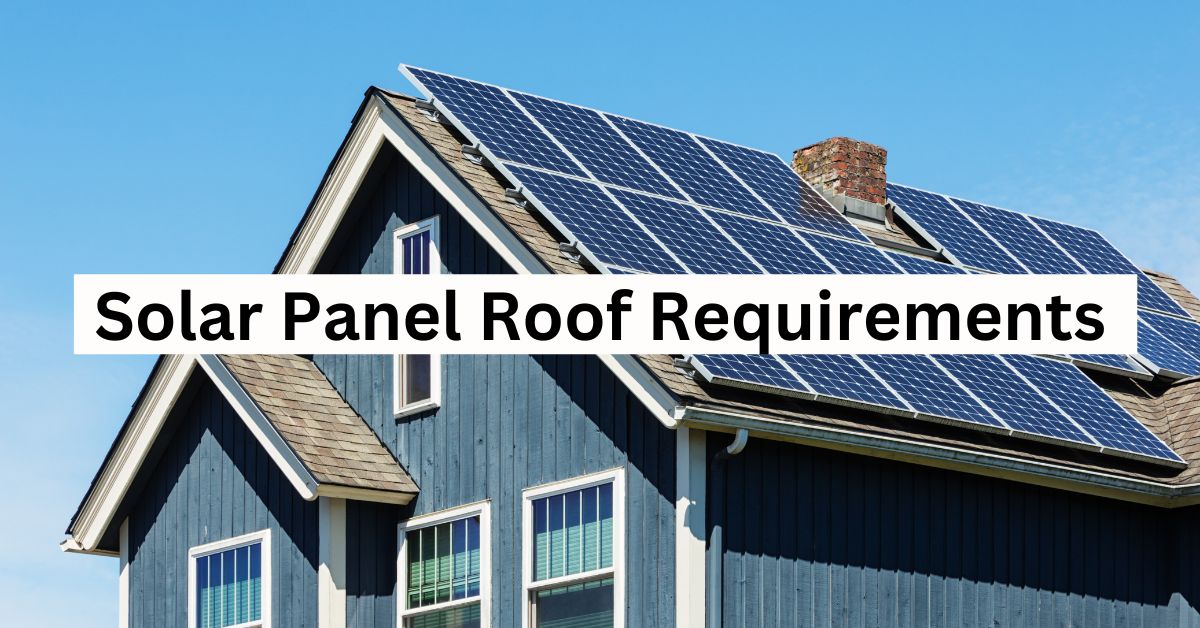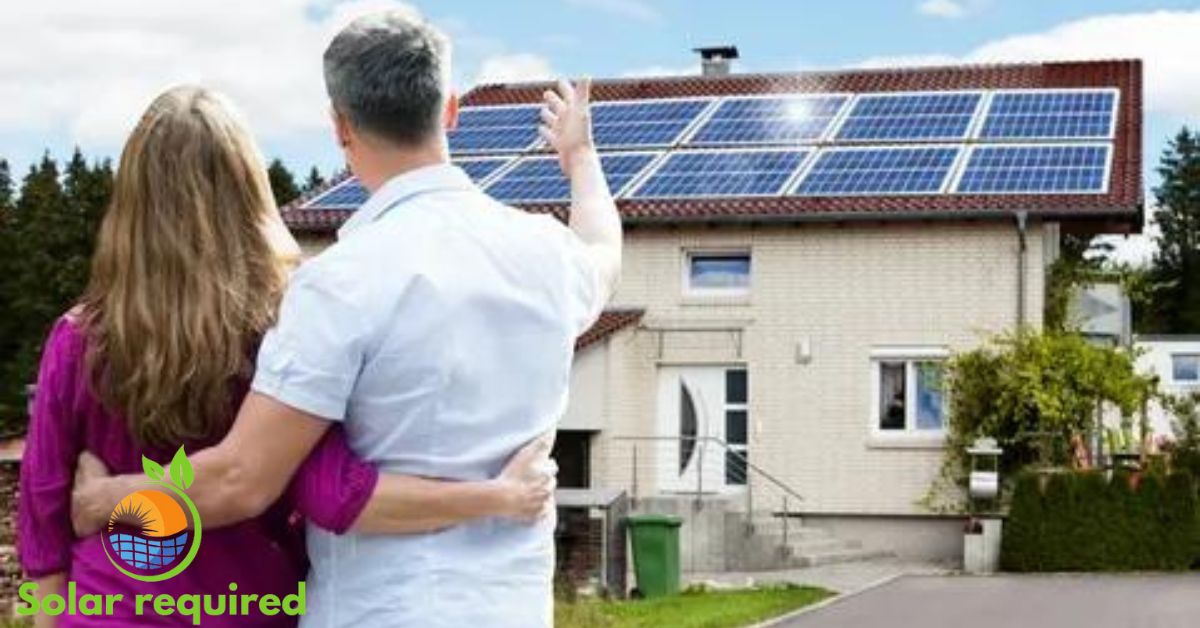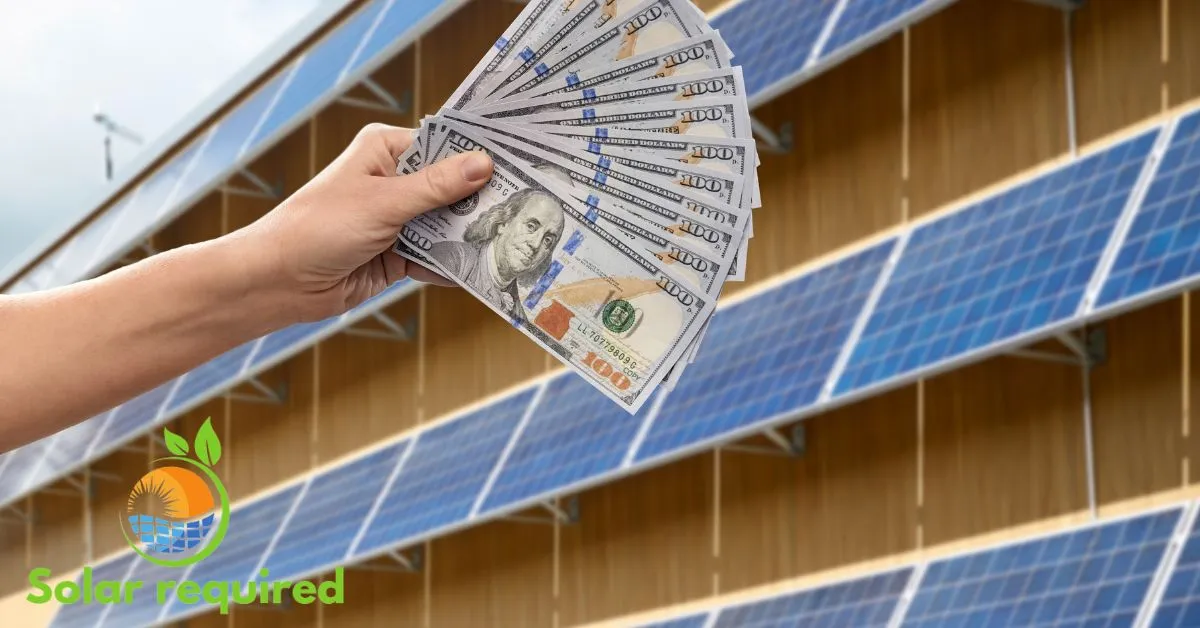Homeowners and property owners interested in solar panels must check if their roof is ready. This article will guide you through what your roof needs for solar panels. We’ll examine roof orientation, pitch, load capacity, material, and ventilation.
Key Takeaways
- Understand the importance of roof suitability for optimal solar panel performance and longevity.
- Evaluate your roof’s orientation, pitch, and condition to ensure maximum solar exposure.
- Assess your roof’s load-bearing capacity to support the weight of the solar panel system.
- Identify any obstructions or shading that could impact the efficiency of your solar panels.
- Ensure your roof’s ventilation system is compatible with solar panel installations.
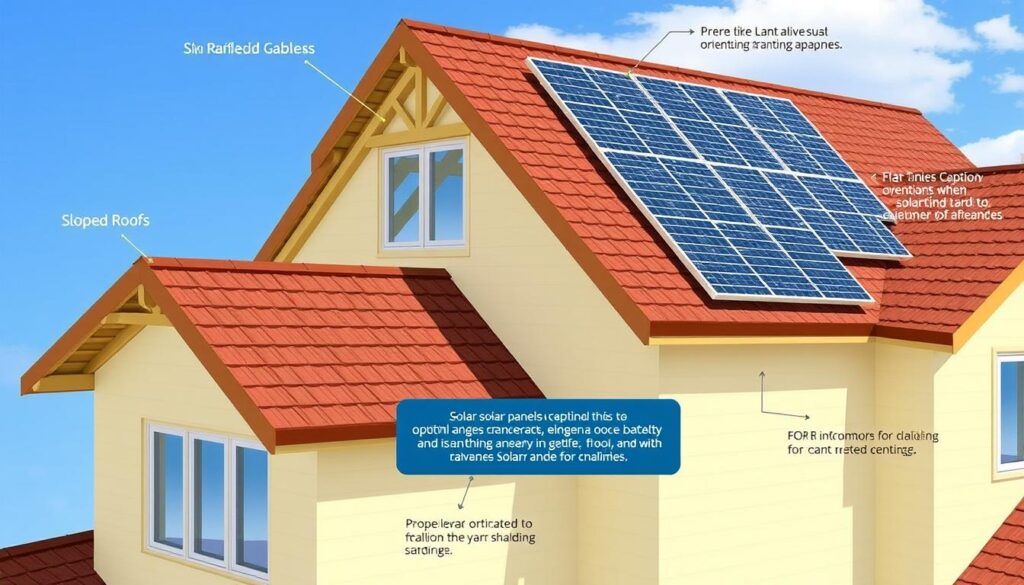
The Importance of Roof Suitability for Solar Panel Installation
The roof is key when installing solar panels. Their orientation, pitch, and materials affect how much solar energy panels can capture. Knowing these details is crucial for homeowners thinking about solar panels.
Recent Post: New Hampshire’s Solar Revolution: How to Access Free Panels Today!
Roof Orientation and Pitch: Optimizing Solar Exposure
The best roof for solar panels faces south, which gets the most sunlight. However, if the pitch is right, roofs facing east or west can also work.
The ideal roof pitch for solar panels is between 15 and 40 degrees. This angle ensures the panels get the most sun.
Homeowners should check their roof’s orientation and pitch. A well-angled roof boosts solar panel efficiency. A bad angle can reduce energy output, making solar panels less worthwhile.
Roof Materials and Condition: Compatibility Considerations
The roof’s material and condition matter for solar panels. Some materials, like metal or asphalt shingles, work better than others. The roof’s state affects installation ease and cost.
A thorough roof check can spot problems before solar panels go up. This ensures a smooth, affordable installation.
Assessing Roof Load Capacity for Solar Panel Systems
Installing solar panels requires checking your roof’s strength. The panels’ weight, mounting system, and extra gear must be considered. This ensures your roof can handle the load without harming the building.
Doing a detailed roof check is key before installing solar panels. This step helps figure out if your roof can handle the load capacity for solar panels. It helps you decide if the solar project is safe and possible.
Here are important things to think about when assessing the roof load capacity for a solar system:
- Roof construction and materials: Know the roofing materials, their thickness, and the roof’s design.
- Existing load-bearing capacity: Find out the maximum weight your roof can hold, including solar panels and their mounts.
- Roof age and condition: Check your roof’s condition, looking for wear, damage, or weaknesses that affect its load-bearing.
By carefully evaluating the roof load capacity for solar panels, you can make sure your home or building is ready. It will support the solar installation without harming your roof’s structure.
It’s wise to talk to a skilled roofing or structural engineer for a professional roof check. They can give you important advice and insights. This helps you choose the best option for your solar project.
Roof Requirements for Solar Panels
Installing solar panels depends a lot on your roof’s condition and fit. It’s important to think about how roof obstructions and shading affect your solar system’s efficiency.
Roof Obstructions and Shading Analysis for Solar Panels
Things like chimneys, vents, and trees can block sunlight and lower your panels’ energy output. A thorough roof shading analysis is key to spotting these issues. It helps place your panels for the best energy production.
This analysis shows the best spot for your panels to avoid shading. It also finds areas on your roof that aren’t good for panels because of too much shade.
| Roof Obstruction | Impact on Solar Panel Performance |
|---|---|
| Chimneys | Can create significant shading, reducing energy output by up to 20% |
| Vents and skylights | May cast shadows, affecting energy generation by 10-15% |
| Trees and other structures | Depending on size and proximity, can reduce energy output by 30-50% |
Knowing how roof obstructions and shading work is key. It helps your solar panel system work its best. This way, you get the most from your investment and save on energy costs.
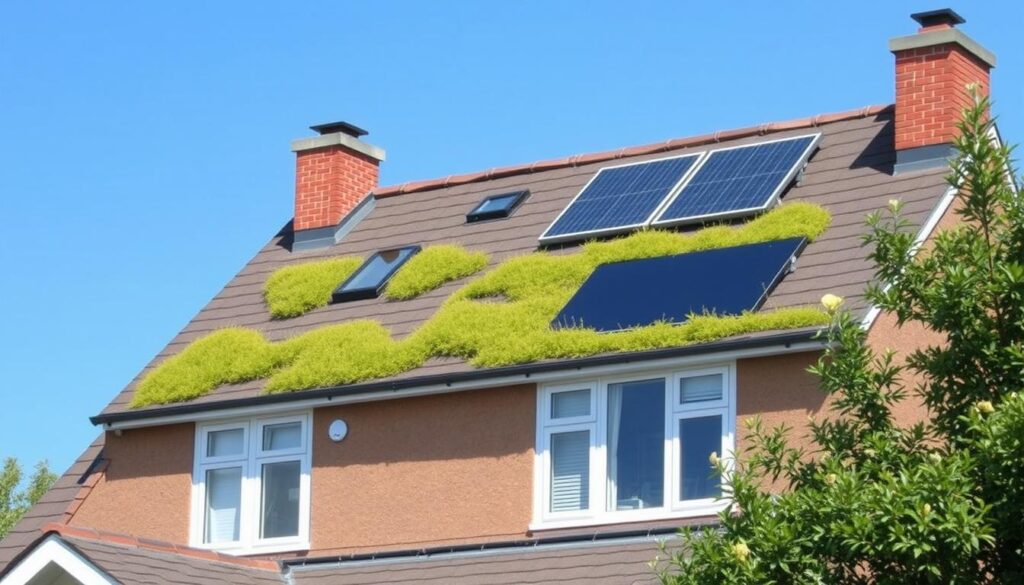
Roof Ventilation Requirements
Proper roof ventilation is key when installing solar panels. It ensures your solar panel system works well and stays safe. Good airflow stops overheating and keeps your panels running efficiently.
A well-designed ventilation system is essential. It helps air move around your panels, cooling them down. This keeps your panels working at their best and can make them last longer.
Every solar panel system has its own ventilation needs. The size of your roof, the type of panels, and your local weather all play a part. A skilled solar installer will check your setup to find the right ventilation solution. This makes sure your system meets all safety and performance standards.
| Roof Ventilation Requirement | Importance |
|---|---|
| Adequate Airflow | Dissipates heat and maintains optimal solar panel operating temperatures |
| Proper Ventilation System Design | Ensures efficient circulation of air around solar panels |
| Customized Ventilation Solutions | Accounts for roof size, panel type, and local climate factors |
By focusing on roof ventilation, you can boost your solar panel system’s performance and lifespan. This ensures you get the best value from your renewable energy investment.
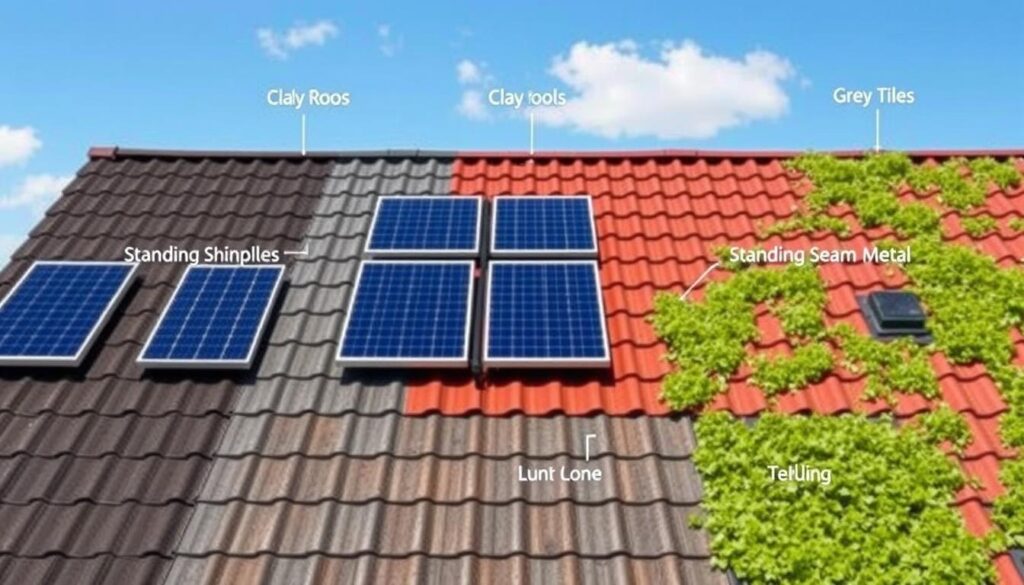
Roofing Materials Compatible with Solar Panels
Choosing the right roofing material is key for solar panels. Homeowners must think about how their roof type works with solar panels. Metal roofs and asphalt shingles have their own special needs for solar panel setup.
Metal Roofs and Solar Panel Mounting
Metal roofs are great for solar panels. They last a long time, which is good for solar energy systems. It’s important to use the right mounts for metal roofs. This ensures the panels stay on without harming the roof.
Asphalt Shingles and Solar Panel Integration
Asphalt shingle roofs are common and can work with solar panels. But, you need to think about how to put them together right. You need special mounts and flashing to keep water out and prevent leaks.
| Roofing Material | Compatibility with Solar Panels | Mounting/Integration Considerations |
|---|---|---|
| Metal Roof | Excellent | Specialized solar mounts and clamps designed for metal surfaces |
| Asphalt Shingles | Good | Careful integration with shingles to maintain the watertight seal, specialized mounting systems, and flashing techniques |

Roof Penetrations and Attachments
Installing solar panels on a roof needs careful roof penetrations and attachments. This ensures the system works well for a long time and keeps the roof safe. Drilling holes or making changes to the roof is part of the job. It’s important to do it right to avoid leaks and keep the roof dry.
Waterproofing and Flashing Considerations
Keeping the roof dry is a big deal with solar panels. Using the right flashing techniques is key to stopping leaks. Roofers or solar installers must use top-notch materials and pay close attention to detail. This creates a strong, weather-resistant seal around the holes.
- Use the right flashing materials, like metal, rubber, or synthetic, to block water.
- Make sure the flashing is placed and sealed correctly to keep water out.
- Think about adding extra waterproofing, like sealants or membranes, for extra protection.
Getting roof penetrations and attachments for solar panels right is crucial. It keeps the roof’s integrity and weatherproofing in top shape. By choosing the right waterproofing and flashing methods, solar installers can make sure the roof penetrations and attachments last a long time for the solar panel system.
| Waterproofing Technique | Advantages | Considerations |
|---|---|---|
| Metal Flashing | Durable, long-lasting, and corrosion-resistant | Requires skilled installation to ensure proper sealing |
| Rubber Flashing | Flexible, easy to install, and adaptable to various roof types | May have a shorter lifespan than metal flashing |
| Synthetic Flashing | Lightweight, weather-resistant, and easy to work with | May require additional sealants or membranes for optimal waterproofing |
Solar Panel Roof Mounting Systems
Choosing the right mounting system and racking options is key for a secure solar panel setup. These systems ensure your panels are attached firmly to the roof. They also help position your solar array for the best sunlight exposure.
The flush mount system is a favorite for its sleek look. It makes your solar panels almost invisible on the roof. This system works well on pitched roofs and is simple to install.
Adjustable tilt mounting systems are great for complex roofs. They let you adjust your panels to catch the most sunlight. This boosts energy production all year round.
| Mounting System | Key Features | Roof Compatibility |
|---|---|---|
| Flush Mount | Optimizes solar exposure. Versatile for complex roof designs, allows for seasonal adjustments | Pitched roofs |
| Adjustable Tilt | A variety of roof types | Variety of roof types |
There’s a wide range of solar panel roof mounting systems and solar panel racking systems for every need. Whether your roof is simple or complex, you can find the right solution. This ensures your solar panels work efficiently and securely.
Roof Access for Solar Installations
Installing solar panels requires safe and easy roof access. Solar panels need regular upkeep and sometimes repairs. So, getting to your roof is key to a solar project’s success.
Roof Age and Warranty Implications
Your roof’s age and condition affect solar panel installation. Older roofs might not last long enough for solar systems, which need 20-25 years. Also, the roof’s warranty might not cover damage from solar panels, leading to expensive fixes.
Before getting solar panels, check your roof’s age and warranty. If your roof is old or has a short warranty, you might need to replace it first. This ensures your solar panels work well for years.
| Roof Age | Warranty | Compatibility with Solar |
|---|---|---|
| 0-10 years | 20-30 years | Highly compatible |
| 10-20 years | 10-20 years | Moderately compatible |
| 20+ years | Less than 10 years | Low compatibility, consider roof replacement |
Thinking about your roof’s age and warranty is crucial. It helps make sure your solar panels are a good long-term choice. This way, you get the most out of your renewable energy.
Roof Inspections and Assessments
Before you install solar panels, it’s key to check your roof carefully. This step helps find any problems or repairs needed. It makes sure your roof can handle the solar system.
By checking your roof’s condition, you can avoid expensive issues later. This way, you get the most out of your solar investment.
Read: Solar Panel Installation Costs in the U.S 2025 Update
Identifying Potential Roof Repair Needs
A detailed roof check looks at the roof’s strength, material, and whether it’s good for solar panels. Experts will look at the roof’s age, slope, direction, and any damage. They’ll also check for any blocks.
This thorough check shows the roof’s current state. It also points out any repairs or upgrades needed before installing solar panels.
Fixing roof problems is important for the solar system’s long-term work and safety. Inspectors might suggest fixing damaged shingles, strengthening the roof, or better ventilation. Fixing these issues early prevents leaks, structural failures, or other problems that could harm the solar panels and their energy output.
FAQ
What are the key considerations for roof orientation and pitch when installing solar panels?
For solar panels, the best roof direction is south-facing. This gets the most sun all day. The roof should be pitched between 15-45 degrees for the best energy capture.
How do I know if my roof materials are compatible with solar panels?
Most roofs, like asphalt shingles, metal, and tile, work well with solar panels. But, check your roof’s condition. It must handle the solar system’s weight without damage.
What is the importance of assessing my roof’s load capacity before installing solar panels?
Knowing your roof’s load capacity is key. It ensures your roof can bear the solar panels and their mounts safely. A check will tell you if your roof is up to the task.
How do roof obstructions and shading impact the performance of solar panels?
Things like chimneys and trees can block sunlight and lower panel efficiency. A shading analysis is needed to find and fix these issues. This ensures your panels get the most sun.
What are the roof ventilation requirements for solar panel installations?
Good roof ventilation is vital for solar panels. It keeps them cool and working well. The exact needs depend on local rules and the panel maker’s advice.
Which roofing materials are most compatible with solar panel installations?
Metal and asphalt shingles are top choices for solar panels. Metal is strong and lasts long. Shingles are easy to add solar panels to.
How do I ensure proper waterproofing and flashing for roof penetrations required by solar panels?
Solar panels need special sealing and flashing to keep your roof dry. It’s best to get a pro to make sure it’s done right.
What types of solar panel roof mounting systems and racking options are available?
There are many mounting systems, like flush and tilt mounts. The right one depends on your roof. A pro can help pick the best one for you.
What are the key safety and access considerations for a solar panel installation on my roof?
Safety and easy access are crucial for solar panels. Check your roof’s age and condition. Make sure it’s safe for maintenance and emergencies.
What type of roof inspection and assessment is required before installing solar panels?
A detailed roof check is needed before installing solar panels. Look at the roof’s structure, age, and condition. Fix any issues to ensure it can hold the solar system.
